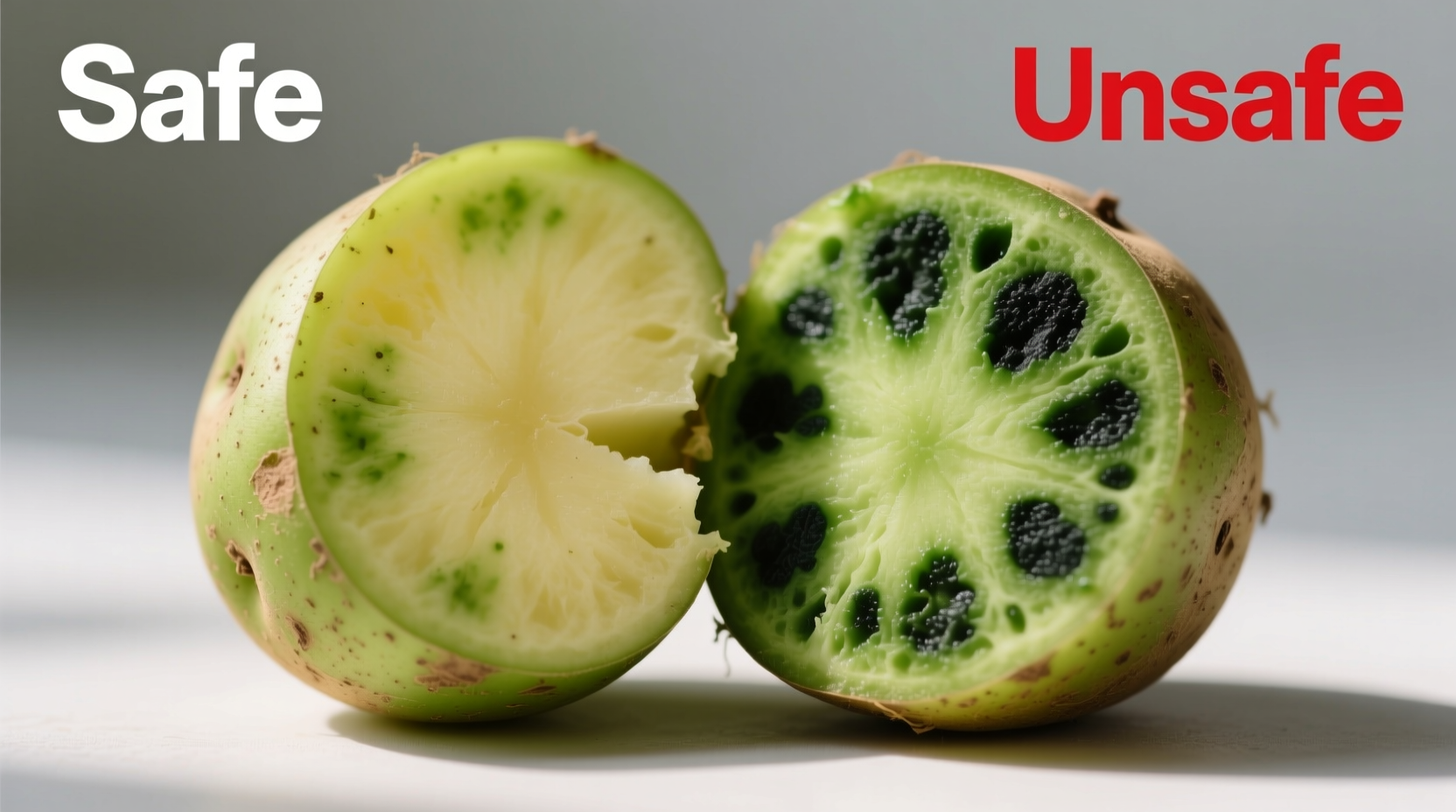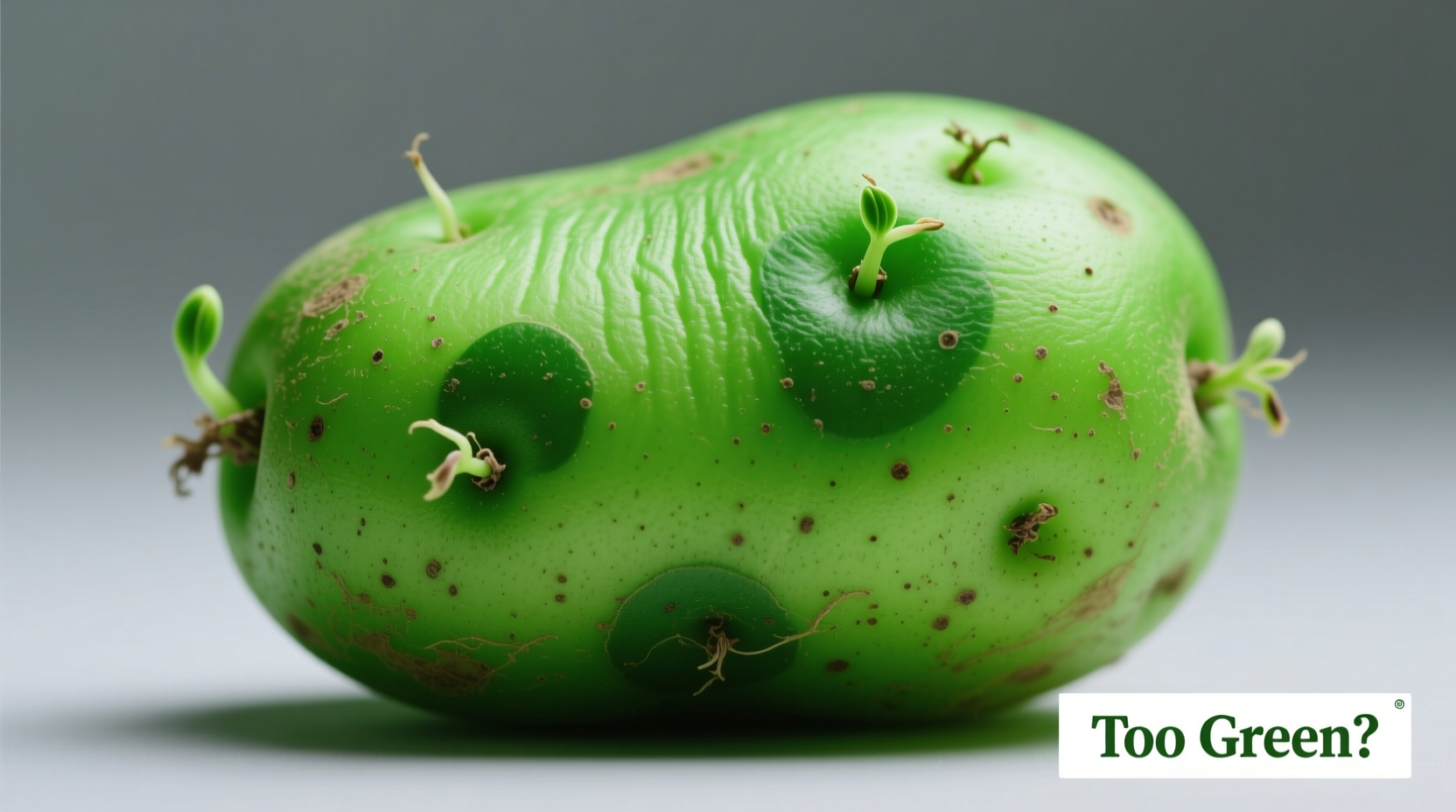Direct Answer: Potatoes become unsafe when green areas exceed 15% of the surface or when green spots are accompanied by sprouting and bitterness. The green color indicates chlorophyll, which itself isn't harmful but signals elevated solanine levels—a natural toxin that can cause nausea, headaches, and neurological issues at concentrations above 20mg/100g.
Why Potatoes Turn Green and When It Becomes Dangerous
When you pull potatoes from your pantry and notice green patches, your immediate concern should be food safety—not just aesthetics. That green tint isn't just unsightly; it's nature's warning sign that your potatoes may contain elevated levels of solanine, a glycoalkaloid toxin produced when potatoes are exposed to light.
Understanding exactly how green is too green requires knowing both visual indicators and the science behind potato greening. This guide delivers actionable information you can use immediately to protect your family's health while reducing food waste.
The Science Behind Green Potatoes
When potatoes are exposed to light—whether natural sunlight or artificial lighting—they produce chlorophyll (the green pigment in plants) as part of photosynthesis. While chlorophyll itself is harmless, its presence correlates with increased solanine production.
Solanine serves as the potato's natural defense mechanism against pests and sunlight damage. The problem is that solanine isn't broken down by cooking and can accumulate to dangerous levels in improperly stored potatoes.
| Greening Level | Solanine Concentration | Safety Assessment |
|---|---|---|
| Minimal surface greening (under 5%) | 5-10 mg/100g | Generally safe after peeling green areas |
| Moderate greening (5-15%) | 10-20 mg/100g | Caution advised; peel deeply or discard if bitter |
| Extensive greening (over 15%) | 20+ mg/100g | Unsafe; discard entire potato |
| Greening with sprouting | 25-100+ mg/100g | Highly toxic; immediate disposal required |
How to Assess Your Green Potatoes: A Step-by-Step Guide
Step 1: Visual Inspection
Examine your potato under good lighting. Note:
- Percentage of green surface area
- Presence of sprouts (especially long or numerous sprouts)
- Texture changes (soft spots, wrinkling)
Step 2: The Smell and Taste Test (With Caution)
If greening is minimal:
- Peel the green areas deeply (1/4 inch minimum)
- Smell the exposed flesh—bitter or earthy odors indicate solanine
- Only if no odor, taste a tiny raw piece—bitterness means discard immediately
Never consume potatoes that taste bitter—this indicates dangerous solanine levels that cooking won't eliminate.
Step 3: Context Boundaries: When Green Potatoes Might Be Salvageable
Not all green potatoes must be discarded. Consider these context boundaries:
- Surface-only greening: If green appears only on the very surface (less than 1/8 inch deep) and affects less than 10% of the potato, deep peeling may make it safe
- Young potatoes: New potatoes naturally have thinner skins and may show slight greening without dangerous solanine levels
- Storage conditions: Potatoes stored in cool, dark places that developed minor greening during transport may be safer than those greened in your warm kitchen
However, if greening extends beyond the surface layer, affects more than 15% of the potato, or appears with sprouting—you must discard the entire potato. Solanine concentrates in and just below the skin, so superficial peeling won't remove it from significantly green potatoes.

What to Do With Slightly Green Potatoes
If your assessment shows minimal greening:
- Peel at least 1/4 inch below all green areas
- Remove all sprouts and eyes completely
- Soak peeled potatoes in cold water for 15-20 minutes before cooking
- Cook thoroughly—while this doesn't destroy solanine, it makes any remaining bitterness more detectable
Remember that how much green on potato is bad depends on both visual assessment and sensory confirmation. When in doubt, throw it out—solanine poisoning isn't worth the risk.
Preventing Potato Greening: Best Practices
Follow these storage guidelines from the USDA Agricultural Research Service to prevent greening:
- Store potatoes in a cool, dark place between 45-50°F (7-10°C)
- Use opaque containers or paper bags—not plastic which traps moisture
- Keep away from onions (they release gases that accelerate sprouting)
- Check stored potatoes weekly and remove any showing early greening
- Buy only what you'll use within 2-3 weeks for optimal freshness
Proper storage prevents the greening process before it begins, addressing the root cause of how green is too green for a potato.
When to Definitely Discard Green Potatoes
Immediately discard potatoes showing any of these warning signs:
- Green color extending more than 1/8 inch below the surface
- Green areas covering more than 15% of the potato
- Presence of long sprouts (over 1/2 inch)
- Bitter taste or odor after peeling
- Soft spots or mold accompanying greening
According to the FDA's guidelines on vegetable safety, potatoes with these characteristics pose a genuine health risk that cannot be mitigated through preparation methods. Can you eat slightly green potatoes? Only when greening is minimal and passes the sensory tests—never when these danger signs appear.
Understanding Solanine Toxicity Levels
The threshold for solanine toxicity varies by body weight and individual sensitivity, but research from the Journal of Agricultural and Food Chemistry indicates:
- 20-25 mg/100g: Threshold for potential symptoms in sensitive individuals
- 25-50 mg/100g: Likely to cause gastrointestinal symptoms
- 50-100 mg/100g: Can cause neurological symptoms
- 100+ mg/100g: Potentially life-threatening
A medium potato (150g) with 20mg/100g solanine contains 30mg total—enough to cause symptoms in children or sensitive adults. This explains why potato solanine levels chart information is critical for family food safety.
Common Misconceptions About Green Potatoes
Several myths persist about green potatoes that could put your health at risk:
- Myth: "Cooking destroys solanine"
- Fact: Solanine is heat-stable and not significantly reduced by boiling, baking, or frying
- Myth: "Only the green parts are toxic"
- Fact: Solanine spreads beneath the surface—greening is just the visible indicator
- Myth: "Peeling makes any green potato safe"
- Fact: Deep greening means solanine has penetrated the entire potato
These misconceptions explain why many people incorrectly believe they can remove solanine from potatoes through standard preparation methods.











 浙公网安备
33010002000092号
浙公网安备
33010002000092号 浙B2-20120091-4
浙B2-20120091-4